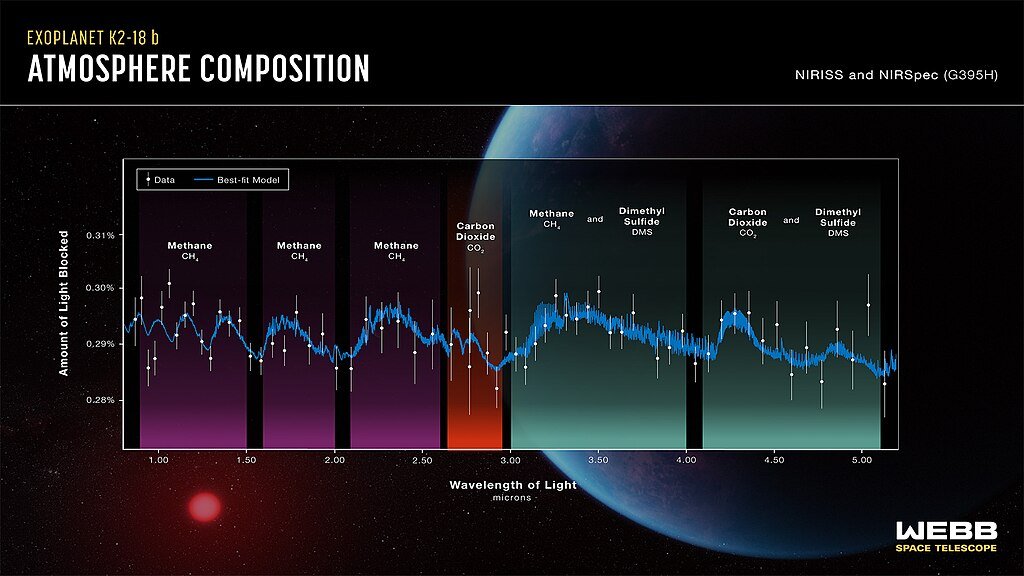New James Webb Telescope data reveals tantalizing hints of biological activity on a distant water world but scientists urge cautious optimism.
A Whisper From 120 Light-Years Away

The James Webb Space Telescope (JWST) has detected what may be the most promising evidence yet for extraterrestrial life:
- Dimethyl sulfide (DMS) signatures in the atmosphere of K2-18b, a “Hycean” exoplanet
- Concentrations thousands of times higher than Earth’s marine biosphere produces
- Supporting detections of methane, CO₂, and hydrogen all hallmarks of potential biological activity
“This isn’t just another blip it’s a siren call from the cosmos,” says lead researcher Prof. Nikku Madhusudhan (University of Cambridge).
The Goldilocks Zone’s Most Mysterious Tenant

K2-18b defies easy categorization:
- Size: 2.6x Earth’s radius
- Orbit: 33-day year in its star’s habitable zone
- Composition: Possible liquid water ocean beneath hydrogen-rich atmosphere
- Temperature: Estimated -73°C to +47°C (-100°F to +116°F) surface range
Critical finding: JWST data shows no ammonia a key indicator the planet isn’t a mini gas giant but may host a global ocean.
The Biosignature Debate: Hope vs. Skepticism
While the DMS detection excites astrobiologists, caveats remain:
| Evidence For Life | Alternative Explanations |
| DMS/DMDS (marine life markers) | UV-driven atmospheric chemistry |
| Methane spikes | Geothermal vent activity |
| CO₂ without ammonia | Molten rock ocean absorbing gases |
“Finding DMS on a comet proves nature can fake biosignatures,” cautions Dr. Michaela Musilova (International Space University).
The Statistical Tightrope
Current data sits at 3 sigma confidence (99.7% certainty) strong but not definitive:
- 5-sigma standard (99.99997%) needed for confirmation
- Next steps: Additional JWST observations in 2024-2025
- Critical test: Hunt for ethane byproducts that should form if DMS is breaking down
“We’re 30% up the mountain with 70% still to climb,” admits Madhusudhan.
A Galactic Perspective

If confirmed, the implications are staggering:
- Life could be common in hydrogen-rich exoplanet oceans
- Hycean worlds (2.5-10x Earth’s size) may be prime hunting grounds
- Future telescopes like Habitable Worlds Observatory could image atmospheric clouds
“This isn’t about one planet it’s about rewriting our place in the universe,” says Dr. Subir Sarkar (Cardiff University).
Why Scientists Are Tempering Excitement

History offers cautionary tales:
- 2019: Phosphine on Venus later attributed to sulfur dioxide
- 2021: K2-18b’s initial CO₂ detection challenged by reanalysis
- 2023: First DMS hints on K2-18b failed independent verification
“Extraordinary claims require extraordinary evidence we’re not there yet,” stresses Prof. Chris Lintott (BBC The Sky at Night).
The Road to Certainty

Definitive answers may come by 2026 via:
- Extended JWST monitoring (12+ transits)
- Cross-validation by competing research teams
- Laboratory experiments simulating Hycean atmospheres
“Patience isn’t just virtuous, it’s a scientific necessity,” reminds Dr. Eddie Schwieterman (UC Riverside).
Sources:
Scientists find ‘strongest evidence yet’ of life on distant planet , Source: Youtube , Uploaded: BBC News

Jan loves Wildlife and Animals and is one of the founders of Animals Around The Globe. He holds an MSc in Finance & Economics and is a passionate PADI Open Water Diver. His favorite animals are Mountain Gorillas, Tigers, and Great White Sharks. He lived in South Africa, Germany, the USA, Ireland, Italy, China, and Australia. Before AATG, Jan worked for Google, Axel Springer, BMW and others.



